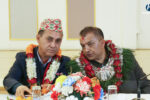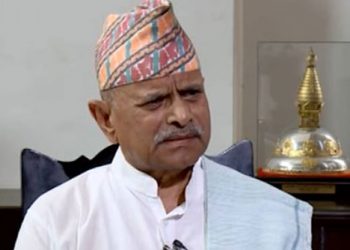To address the challenges of inclusion, it’s essential to clarify our understanding of the constitution—its expectations and the current reality.
A clear framework will facilitate the identification of necessary amendments and modifications.
When discussing the constitution, we must be mindful of our original expectations and our present situation.
Establishing standards for evaluating our expectations and the status of implementation is crucial.
It seems that the drafting of the constitution was not grounded in a judicial perspective or constitutional integrity.
As members of the Constituent Assembly, many of us hailed from villages, and I was among those who aimed to establish representation and accessibility for the people through political parties, balancing political power.
Thus, the constitution can be seen as a compilation of various political manifestos.
BP Koirala noted that “the constitution is a document of the balance of political powers.”
It is unnecessary to tie the constitution to any specific party or individual; rather, it reflects the political balance of its time.
The local level has not been able to develop as expected. Some work is being done at the local level, but the instability at the central level is rapidly affecting the provinces, causing significant disruption.
In the initial Constituent Assembly, the Maoists emerged as the dominant force, followed by the Nepali Congress and UML.
By 2070 BS, the hierarchy had shifted, with the Nepali Congress leading, the CPN-UML second, and the Maoists third.
This fluctuation illustrates that the constitution’s creation was aligned with the prevailing balance of power, not any single party’s ideology.
There are notable deficiencies in legal procedures. Even our current ruling coalition acknowledges the need to address weaknesses and complexities.
However, vague terms like “deficiency” and “complexity” only serve to obscure the issues surrounding constitutional amendments, perpetuating instability.
Importantly, we view the constitution as a living document that requires ongoing adaptation.
Central to this is how political power is distributed at the union, state, and local levels, and whether government agencies operate effectively within that framework.
The constitution’s ultimate goal is to foster economic prosperity and national unity.
While differing opinions on foreign policy are inevitable, a consensus-driven approach is essential for stability, as envisioned in the constitution.
Currently, Nepal is experiencing an increasing reliance on foreign influence to maintain power. We must consider how the constitution can regulate this trend moving forward.
Reducing Administrative Expenses
In discussions with foreign observers, it has been noted that we employ approximately 80,000 to 90,000 personnel, but many of their roles could be effectively fulfilled by just 20,000 trained employees.
This surplus leads to inefficiency, as only a fraction of the workforce can handle the necessary tasks.
To optimize our administration at all levels—central, state, and local—we must reduce expenses and streamline operations.
This reduction is critical for ensuring effective governance and alleviating the burden on citizens.
Addressing Provincial Instability
A significant challenge arises when there are shifts in central government. Often, changes at the national level lead to instability in provincial governments, disrupting development even when local levels remain stable.
This instability can be mitigated by appointing governors or establishing other bodies to stabilize provincial administrations.
Exploring constitutional reforms or amendments to stabilize provincial governance could be a productive avenue for discussion.
By addressing these issues, we can enhance the effectiveness of governance and ensure a more inclusive political landscape.
Is the Nepali constitution pursuing inclusion to empower people from specific genders, castes, communities, or regions, or is it merely replicating existing dynamics? This is an important consideration.
The local level has not been able to develop as expected. Some work is being done at the local level, but the instability at the central level is rapidly affecting the provinces, causing significant disruption.
To address this, we can stabilize the provinces by appointing governors or utilizing other bodies to implement necessary constitutional reforms or amendments. This topic merits further discussion.
Question of Trust
Regarding the union, we have arranged that no motion of no confidence can be raised within two years after a failed motion.
While we implemented this arrangement, political parties frequently participated and withdrew, complicating the situation.
The record of the confidence vote during former Prime Minister Prachanda’s tenure highlights this instability.
We attempted to control motions of no confidence, but the process of taking a confidence vote ultimately led to changes in government.
This attempt to stabilize the situation through constitutional measures has not yielded lasting results.
Now, we need to explore which processes and practices can provide stability to the country.
How can we ensure stable governments at both the central and provincial levels? We must draw insights from the experiences of this constitution moving forward.
Distortion of Proportional Inclusion
Much has been said about equality and inclusion, which are indeed positive concepts.
However, the term “inclusion” often leads to a significant repetition of individuals from the same class or family.
Is the Nepali constitution pursuing inclusion to empower people from specific genders, castes, communities, or regions, or is it merely replicating existing dynamics? This is an important consideration.
For instance, simply bringing in sons or nephews from tribal, Dalit, or Madhesi communities does not strengthen those communities. Similarly, replacing husbands with sons or daughters does not address gender issues.
Thus, we need to have a productive debate on how to ensure effective inclusion. If we proceed by approving inclusive representation through electoral processes, we can establish competent leadership.
There are significant issues regarding political parties that require reform. While political parties exist, the laws meant to ensure inter-party democracy are not effectively enforced, limiting the courts’ ability to intervene.
BP Koirala argued that while King Mahendra sought development through administrative means, he aimed to achieve it through political parties.
BP believed that engaging the populace through political parties would lead to faster development than administrative processes alone.
Today, we must ask whether we have truly brought in representatives from marginalized communities.
Are we merely replacing one Dalit with another, one tribal member with another?
Their participation should stem from a political process rather than merely being absorbed within party structures.
The representation we’ve established in the constitution must have meaningful objectives.
If the National Assembly and the House of Representatives are meant to be equal, why not develop proportional representation by linking the two?
Instead of insisting on 33 percent women in both chambers or maintaining a 45 percent inclusion rate separately, we could balance proportionality by combining both bodies.
After all, they are both parliamentary structures. I see potential for progress through this approach.
Reducing Constitutional Commissions
Numerous commissions have been established, and while inclusivity is important, we could streamline operations by consolidating these commissions.
By expanding the scope of a few larger commissions to ensure broader representation, we could reduce the financial burden on the state treasury. How can we effectively regulate this?
Concerns Regarding the Hearing Committee
The constitution provides for a hearing committee, but its current function often appears to be a mere facade.
Whether composed of judges, ambassadors, or others, it seems to devolve into a platform for ridicule rather than serious evaluation.
There are instances of character assassination through complaints made against individuals by name.
To enhance its effectiveness, why not implement a system where a two-thirds majority can reject nominations, rather than engaging in endless debate?
There is considerable discourse surrounding religion. I believe that the identity of any country or society is shaped by respect for and appreciation of its traditional values.
In the U.S., if two-thirds of Congress votes against a nomination, that name cannot proceed through any hearing committee. Why can’t we adopt a similar approach in Nepal? This could be a viable path forward.
Reforms in the Judiciary
The judiciary is currently under scrutiny, particularly from the Bar Association, which continues to voice concerns. The tenure of Chief Justices lacks guarantees, leading to prolonged uncertainty.
As a constitutional body, we must also address the role of judges, and I believe we should pursue reforms in this area.
Reforms in Political Parties
There are significant issues regarding political parties that require reform. While political parties exist, the laws meant to ensure inter-party democracy are not effectively enforced, limiting the courts’ ability to intervene.
Ensuring Inter-Party Democracy
To amplify the voices of cadre members within political parties, it is essential to ensure inter-party democracy.
Should we embed arrangements for this in the constitution and closely observe the electoral processes of political parties?
Alternatively, should we focus on the financial aspects or delegate authority to the Election Commission or another body?
We must consider how to promote transparency within political parties and explore this perspective further.
The Issue of Thresholds
Establishing a threshold is crucial for political stability. We must discuss the appropriate level and percentage for this threshold, aiming for national consensus on the matter.
However, a significant issue remains: the current constitution has failed to prevent the fragmentation of political parties. Whether through ordinances or other means, parties continue to split.
The constitution has not effectively addressed this ongoing fragmentation. Therefore, we should advance discussions on institutional reforms that foster stability within parties and minimize divisions.
The Role of Religion
There is considerable discourse surrounding religion. I believe that the identity of any country or society is shaped by respect for and appreciation of its traditional values.
This understanding allowed us to enshrine in the constitution the freedom of all religions while ensuring the protection and promotion of traditional values. This approach seems promising.
(Edited excerpt from remarks made by Nepali Congress leader and former Foreign Minister NP Saud during a program organized by the Constitution Watch Group and ISSR at Hotel Malla in Lanchaur on Monday.)








Comment